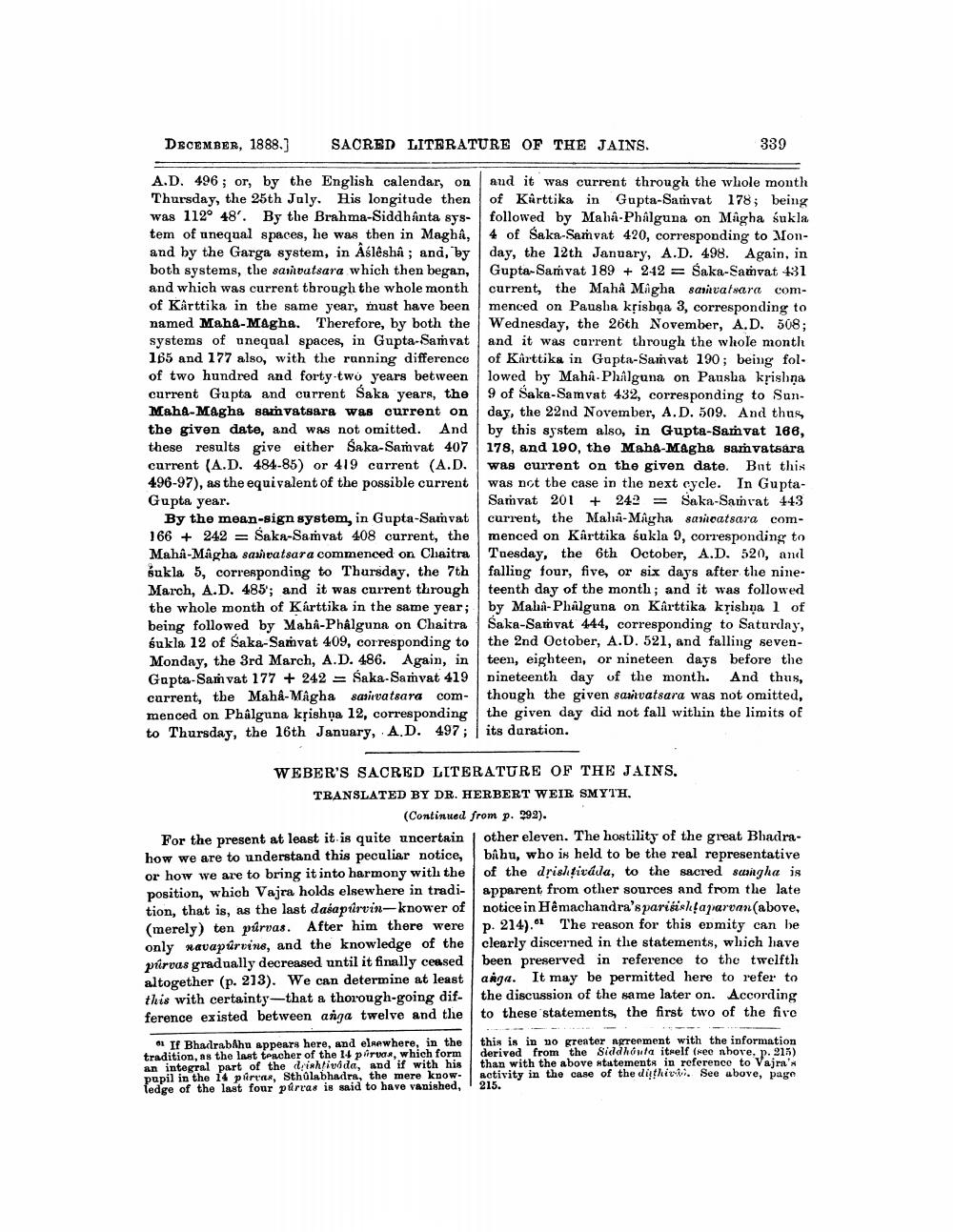________________
SACRED LITERATURE OF THE JAINS.
339
A.D. 496; or, by the English calendar, on and it was current through the whole month Thursday, the 25th July. His longitude then of Karttika in Gupta-Satvat 178; being was 112° 48'. By the Brahma-Siddhanta sys- followed by Maha-Phálguna on Magha sukla tem of unequal spaces, he was then in Magb, 4 of Saka-Samvat 420, corresponding to Monand by the Garga system, in Aślêsha ; and," by day, the 12th January, A.D. 498. Again, in both systems, the samvatsara which then began, Gupta-Saṁvat 189 + 242 = Saka-Samvat 131 and which was current through the whole month current, the Maha Migha sarivatsara comof Kärttika in the same year, must have been menced on Pausha krishqa 3, corresponding to named Maha-Magha. Therefore, by both the Wednesday, the 26th November, A.D. 508; systems of unequal spaces, in Gupta-Samvat and it was current through the whole month 165 and 177 also, with the running difference of Kirttika in Gupta-Samvat 190; being fol. of two hundred and forty-two years between lowed by Maha Phalguna on Pausha krishna current Gupta and current Saka years, the 9 of Saka-Samvat 432, corresponding to SunMaha-Magha samvatsara was current on day, the 22nd November, A.D. 509. And thus the given date, and was not omitted. And by this system also, in Gupta-Samvat 166, these results give either Saka-Samvat 407 178, and 190, the Mahl-Magha samvatsara current (A.D. 484-85) or 419 current (A.D. was current on the given date. But this 496-97), as the equivalent of the possible current was not the case in the next cycle. In GuptaGupta year.
Samvat 201 + 242 = Saka-Samvat 443 By the mean-sign system, in Gupta-Sainvat current, the Maha-Magha sanoatsara com166 + 242 = Saka-Samvat 408 current, the menced on Karttika śukla 9, corresponding to Maha-Magha sahvatsara commenced on Chaitra Tuesday, the 6th October, A.D. 520, and sukla 5, corresponding to Thursday, the 7th falling four, five, or six days after the nine. March, A.D. 485'; and it was current through teenth day of the month; and it was followed the whole month of Kárttika in the same year; by Maha-Phålguna on Karttika krisbna l of being followed by Mahi-Phâlguna on Chaitra Saka-Samvat 444, corresponding to Saturday, sukla 12 of Saka-Samvat 409, corresponding to the 2nd October, A.D. 521, and falling sevenMonday, the 3rd March, A.D. 486. Again, in teen, eighteen, or nineteen days before the Gapta-Saṁ vat 177 + 242 = Saka-Samvat 419 nineteenth day of the month. And thus, current, the Maha-Magha sasivatsara com- though the given samvatsara was not omitted, menced on Phålguna kțishņa 12, corresponding the given day did not fall within the limits of to Thursday, the 16th January, A.D. 497; its duration.
WEBER'S SACRED LITERATURE OF THE JAINS. TRANSLATED BY DR. HERBERT WEIR SMYTH,
(Continued from p. 292). For the present at least it is quite uncertain other eleven. The hostility of the great Bhadrahow we are to understand this peculiar notice, bihu, who is held to be the real representative or how we are to bring it into harmony with the of the drishtivada, to the sacred sangha is position, which Vajra holds elsewhere in tradi- apparent from other sources and from the late tion, that is, as the last dasapurvin-knower of notice in Hêmachandra's varikirlete (merely) ten púrvas. After him there were p. 214). The reason for this epmity can be only navapúrvine, and the knowledge of the clearly discerned in the statements, which have prirvus gradually decreased until it finally ceased been preserved in reference to the twelfth altogether (p. 213). We can determine at least anga. It may be permitted here to refer to this with certainty-that a thorough-going dif- the discussion of the same later on. According ference existed between anga twelve and the to these statements, the first two of the five
If BhadrabAho appears here, and elsewhere, in the tradition, as the last teacher of the 14 piirvar, which form an integral part of the linhlivada, and if with his popil in the 14 partes, Sthalabhadra, the mere know- ledge of the last four parras is said to have vanished,
this is in no greater agreement with the information derived from the Siddhanta itself (see nhove, p. 215) than with the above statements in reference to Vajra's activity in the case of the dirthivi. See above. Dave 215.




